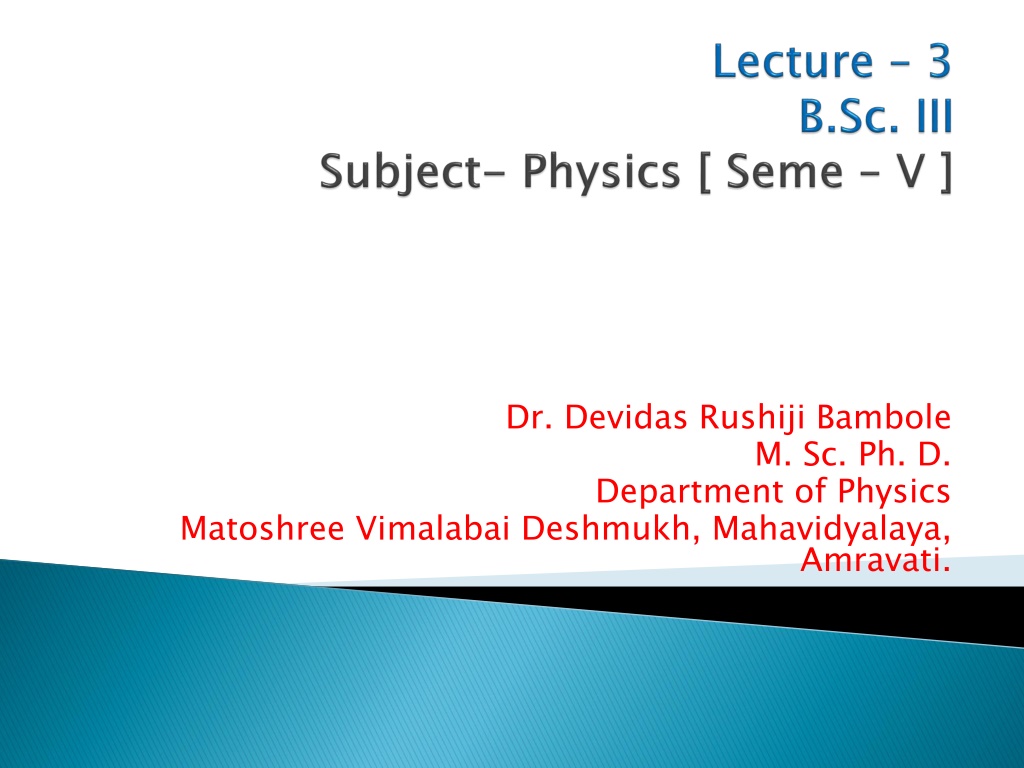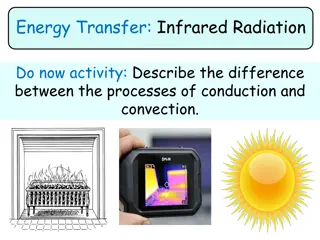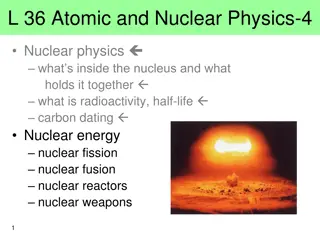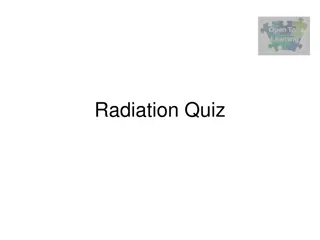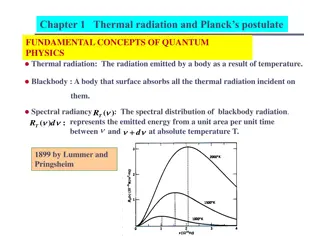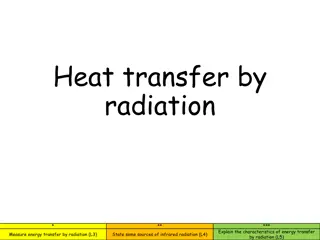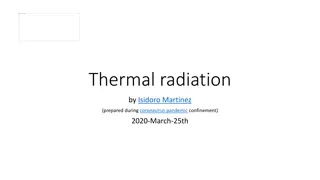Understanding Blackbody Radiation and Its Laws
Explore the concept of blackbody radiation and key laws governing it, including Wien's displacement law and Stefan's law. Learn how the blackbody spectrum depends on temperature, the shift in peak energy with temperature changes, and more. Dive into experimental facts and the implications of temperature on emitted energy.
Download Presentation

Please find below an Image/Link to download the presentation.
The content on the website is provided AS IS for your information and personal use only. It may not be sold, licensed, or shared on other websites without obtaining consent from the author. Download presentation by click this link. If you encounter any issues during the download, it is possible that the publisher has removed the file from their server.
E N D
Presentation Transcript
Dr. Devidas Rushiji Bambole M. Sc. Ph. D. Department of Physics Matoshree Vimalabai Deshmukh, Mahavidyalaya, Amravati.
Blackbody Radiation: 1) Any object with a temperature above absolute zero emits light at all wavelengths. If the object is perfectly black (so it doesn't reflect any light), then the light emitted by the object is called as blackbody radiation The energy of blackbody radiation is not same for all wavelengths of light. The spectrum of blackbody radiation shows that some wavelengths get more energy than others. Three spectra are shown, for three different temperatures. (One of the curves is for the surface temperature of the Sun, 5770 K.) blackbody radiation.
Some experimental facts about blackbody radiation are as follows:
a) The blackbody spectrum depends only on the temperature of the object, and not on material of the object. An iron horseshoe, a ceramic pot, and a piece of charcoal --- all emit the same blackbody spectrum if their temperatures are the same. b) As the temperature of an object increases, it emits more energy at all wavelengths. c) As the temperature of an object increases, the maximum energy peak of the blackbody spectrum shifts towards lower wavelength side. d) The blackbody spectrum always becomes small at the left-hand side (the short wavelength side).
: : Wiens displacement law states that - As the temperature of black body is increased, the maximum energy represented by the peak of the curve shifts towards shorter wavelength side. Mathematically, m m = Constant . m . T = constant. Where, m is the wavelength having maximum energy corresponding to temperature T. This is known as Wien s displacement law.
Stefans law: energy E given out by a perfectly black body per second per unit area is directly proportional to the fourth power of the absolute temperature T. Where, is a constant called Stefan s constant The value of = 5.67 x Stefan s law: It states that - The radiation i. e. E = E =
It states that - - The energy density E d i. e. the amount of energy per unit volume lying between the wavelengths and ( + d ) is given by - E d = A d This equation is called as Wien s radiation law. This law is true for short wavelengths only.
Rayleigh-jeans tried to determine the relation for the distribution of energy with wavelength by assuming that- the electromagnetic radiation emitted by a black body continuously vary in wavelength from zero to infinity. This radiation is considered to be monochromatic wave trains and the number of such wave trains within the range and + d is determined by law of probability. The expression comes out to be dE dE = 8 = 8 kT kT d d This equation is known as Rayleigh This law agrees with experimental results for long wavelengths only. This equation is known as Rayleigh- -Jeans law. Jeans law.
According to classical theory, light is an electromagnetic wave. Light is produced when an electric charge vibrates. ("Vibrates" means any change in how the charge moves --- speeding up, slowing down, or changing direction.). In a hot object, electrons vibrate in random directions and so, produce the light. When the body is heated then the electrons in a hot object can vibrate with a range of frequencies, ranging from very few vibrations per second to a large number of vibrations per second. There is no limit of the frequency of vibrations. According to Classical should limit of frequency of vibration, there is no limit to the energy of the vibrating electrons at high frequencies. This means that, according to classical physics, there should be no limit to the energy of the light produced by the electrons vibrating experimentally. The blackbody spectrum always becomes small at the left-hand side (short wavelength, at high frequency). So, classical of Classical theory, have the theory, each same energy each frequency energy. . Since there is no greatest frequency of of vibration vibration should have the same at high frequencies. But it is wrong classical theory spectrum. theory could could not not explain explain the the shape shape of the the blackbody blackbody spectrum
Plancks quantum theory for explanation the black body spectrum: At about 1900, Max Planck explains the black body spectrum. He proposed that - the classical idea that each frequency of vibration should have the same energy must be wrong. Instead, he said that energy is not shared equally by electrons that vibrate with different frequencies. Planck said that energy comes in bunch. He called a bunch of energy a quantum The size of a bunch of energy --- a quantum --- depends on the frequency of vibration. This is the Planck's rule for a quantum of energy for a vibrating electron: Energy of a quantum = (Planck's constant) x (frequency of vibration) or E = h f Where, h is called Planck's constant. Its value is about 6 x 10-34. Planck said that an electron vibrating with a frequency f could only have an energy of 1 hf, 2 hf, 3 hf, 4 hf, ... . Energy of vibrating electron = (any integer) x h f But the electron has to have at least one quantum of energy if it is going to vibrate. If it doesn't have at least energy of 1hf, it will not vibrate at all and can't produce any light. According to Planck - at high frequencies, the amount of energy in a quantum, hf, is so large that the high-frequency vibrations cannot be obtained. This is why the blackbody spectrum always becomes small at the left-hand (high frequency) side. Planck s quantum theory for explanation the black body spectrum: quantum.
Plancks radiation law: the amount of energy per unit volume lying between the frequencies and ( + d ) is given by- E( ) d = This is known as Planck s law. Planck s law in terms of wavelength: Substitute = d = - E d = E = = Or Planck s radiation law: The energy density E( ) d i. e. This is known as Planck s law. Planck s law in terms of wavelength: This is known as Planck s radiation law for black body radiation in terms of wavelength. This law completely explains the experimental results about the distribution of energy with wavelength in the spectrum due to radiations from a black body.
